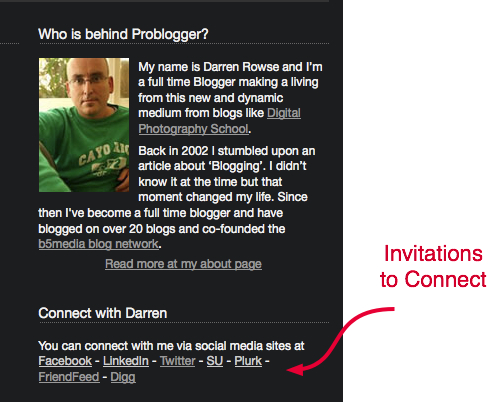Wednesday, October 28, 2009
Put banner ads free and easily in blog
IT'S FREE.
Sent me soon, if you want to put your banner at the top of this blog
Tuesday, October 27, 2009
Seven Personal Characteristics Of A Good Leader
Whether in fact a person is born a leader or develops skills and abilities to become a leader is open for debate. There are some clear characteristics that are found in good leaders. These qualities can be developed or may be naturally part of their personality. Let us explore them further.
SEVEN PERSONAL QUALITIES FOUND IN A GOOD LEADER
1. A good leader has an exemplary character. It is of utmost importance that a leader is trustworthy to lead others. A leader needs to be trusted and be known to live their life with honestly and integrity. A good leader “walks the talk” and in doing so earns the right to have responsibility for others. True authority is born from respect for the good character and trustworthiness of the person who leads.
2. A good leader is enthusiastic about their work or cause and also about their role as leader. People will respond more openly to a person of passion and dedication. Leaders need to be able to be a source of inspiration, and be a motivator towards the required action or cause. Although the responsibilities and roles of a leader may be different, the leader needs to be seen to be part of the team working towards the goal. This kind of leader will not be afraid to roll up their sleeves and get dirty.
3. A good leader is confident. In order to lead and set direction a leader needs to appear confident as a person and in the leadership role. Such a person inspires confidence in others and draws out the trust and best efforts of the team to complete the task well. A leader who conveys confidence towards the proposed objective inspires the best effort from team members.
4. A leader also needs to function in an orderly and purposeful manner in situations of uncertainty. People look to the leader during times of uncertainty and unfamiliarity and find reassurance and security when the leader portrays confidence and a positive demeanor.
5. Good leaders are tolerant of ambiguity and remain calm, composed and steadfast to the main purpose. Storms, emotions, and crises come and go and a good leader takes these as part of the journey and keeps a cool head.
6. A good leader, as well as keeping the main goal in focus, is able to think analytically. Not only does a good leader view a situation as a whole, but is able to break it down into sub parts for closer inspection. While keeping the goal in view, a good leader can break it down into manageable steps and make progress towards it.
7. A good leader is committed to excellence. Second best does not lead to success. The good leader not only maintains high standards, but also is proactive in raising the bar in order to achieve excellence in all areas.
These seven personal characteristics are foundational to good leadership. Some characteristics may be more naturally present in the personality of a leader. However, each of these characteristics can also be developed and strengthened. A good leader whether they naturally possess these qualities or not, will be diligent to consistently develop and strengthen them in their leadership role.
Barbara White President of Beyond Better Development has over twenty years experience in leadership. Beyond Better Development works with organizations who want their leaders to develop towards their potential and stay on the cutting edge. More about Leadership Developmentand Good Leadership Skills
Article Source: http://EzineArticles.com/?expert=Barbara_White
Barbara White - EzineArticles Expert Author
HOW TO BE A GOOD LEADER
* Know your team. At some point, every day, walk around the office and say "Hi" to everyone who works for you. If you're not in the office that day, call and see how people are.
* Meet your team. Regularly - daily, weekly or monthly, depending on your place and type of work - have meetings of all the members of the team. Keep these meetings short, focused and action-orientated.
* Train your team. Every team member should have at least two days training a year. Newer and more senior colleagues should have more. If they don't ask to go on training sessions, suggest some suitable courses.
* Grow your team. Through varied experience and regular training, you should be developing each team member to be more and more confident and more skilled.
* Set objectives for each team member. As far as possible, these objective such be SMART - Specific Measurable Achievable Resourced Timed.
* Review the performance of each team member. At least once a year - at least quarterly for the first year of a new team member - have a review session where you assess performance, give feed-back and agree future objectives and training.
* Inspire your team. Consider making available a motivational quote or story every week or month [for lots of good quotes click here].
* Socialise with your team. Have lunch or an after-work drink with them, especially when a staff member has a birthday or there's another reason to celebrate.
* Thank constantly. The words "Thank you" take seconds to say, but mean so much.
* Praise constantly. The words "Well done" take seconds to say, but will be long remembered and appreciated.
* Communicate constantly. Don't assume that people know what you're doing, still less what you are planning or thinking. Tell them, using all the communication tools to hand: team briefings, electronic newsletters, organisational newspapers.
* Eliminate. Too often we do things because they've always been done. Life changes. Consider whether you could stop doing certain things altogether.
* Delegate. You don't have to do everything. Develop your team members by training them to do more and trusting them to take over some of the things you've been doing.
* Empower. A really effective leader sets clear objectives for his team members, but leaves detailed implementation of these objectives to the discretion and judgement of individual members of the team. As Second World War U.S. General George S. Patton put it: "Don't tell people how to do things. Tell them what to do and let them surprise you with their results”.
* Facilitate. A confident leader does not try to micro-manage his team, but makes it clear that, if team members need advice or assistance, he is always there to facilitate and support.
* Be on time. Always start meetings on time and finish them on time. Natural breaks keep people fresh. Short meetings concentrate the mind.
* Be seen. Don't just talk the talk, but walk the walk. So visit each unit or department for which you are responsible on a regular basis. Don't do this unannounced - you are not out to undermine other leaders or catch out staff. So arrange with the unit leader or departmental head when you'll visit and ask him or her to walk round with you.
* Make time. Managers are often very busy and this can deter people from approaching you, so make time for people and be approachable. People will appreciate you taking five minutes out of your busy schedule, especially if you act on/listen to what they say.
* Really listen. Many of us - especially those who think they are important - don't really listen, but instead think about what they're going to say next. Give the person speaking to you your full attention and really take on board what they are saying. [For more detailed advice on listening click here]
* Accept honest criticism. Criticism is hard to take, particularly from a relative, a friend, an acquaintance or a stranger - but it's a powerful tool of learning. Above all, assess criticism on merit, without regard to its originator.
* Think strategically. The doers cut a path through the jungle; the managers are behind them sharpening the machetes; the leaders find time to think, climb the nearest tree, and shout "Wrong jungle!" Find time to climb the trees.
* Have a mentor or buddy, someone doing similar work in the same or a similar organisation with whom you can regularly and frankly discuss your progress and your problems as a leader.
* Have a role model, someone who can inspire you to be a truly great leader. If you can't find one, study Jed Bartlet as the American President in any episode of the television series "The West Wing".
* Constantly revisit and review these tips. In his seminal work, "The Seven Habits Of Highly Effective People", Stephen Covey puts it this way: "Sharpen the saw".
* Plan your succession. You won't be there forever and you may not be in control of the timing and circumstances of your departure. So start now to mentor and train at least one colleague who could take over from you.
Source: http://www.rogerdarlington.co.uk
Monday, October 26, 2009
Writing Skills Success In 20 Minutes A Day
PHP Code:
http://depositfiles.com/files/1850020
http://rapidshare.de/files/37886246/Wr.rar
http://rapidshare.com/files/57606225/Wr.rar pass
source
http://get4share.com
Coca Cola holds “Skills of success” seminar for Nam Dinh’s students
Coca Cola held a two day workshop titled “Biz in life” for some 700 students and pupils in Nam Dinh Province, which ended yesterday.
The workshop featured two seminars covering the main topics “the career baggage” featuring instruction of soft skills (successful job interview, decision making, effective communication) by experts from Coca Cola and “Experiences of success in studying and life” by professor Tran Van Nhung, deputy minister of Education and Training, who spoke of success stories and experiences.
Vị trí đặt quảng cáoThese were the ninth and tenth seminars of the supporting education program “Biz in life” workshop conducted by Coca Cola in collaboration with the ministry since early this year.
Participating in the workshop in the role of a lecturer for the first time, deputy minister Tran Van Nhung said that he personally supports the programs providing soft skills for students. Good knowledge is one thing but to succeed, students need to make use of this knowledge, which is the role of the soft skills.
Le Van Khoi, public affairs & communications manager of Coca-Cola Southeast Asia Inc., said: “Coca Cola always wants to go farther in its commitment to the Ministry of Education and Training in the “Biz in life workshop” program. We want more students in the whole country to learn more soft skills, therefore, we will definitely maintain the program.”
The “Biz in life” workshop has been held in many universities around the country including Can Tho University, HCMC Social Science and Humanities, University of Agriculture, Danang University, Hanoi University and Hue University of Economics.
source thesaigontimes
Identifying and selling your soft skills
Has your professional training kept you up to date with the skills you need as you progress through your career? You may have undertaken lots of technical training and be at the forefront of industry issues and developments, but highly successful professionals are not just technically aware, they possess ‘soft’ skills, which are becoming increasingly sought after.
Many of us worry about whether we will have good jobs in the future, but the outlook for technical experts who have good soft skills is that they will always be in demand. So how does this relate to you? Your technical skills are important and you should develop your expertise, but these are not the sole means to higher-level opportunities for most people. To climb the ladder you need to be able to clearly and concisely share your technical expertise with your colleagues - this is non-negotiable.
If you are failing to recognise the growing importance of soft skills you could be missing out on excellent opportunities, so identify which skills you have by considering what you do well and how you approach certain situations and problems.
What attributes are regarded as soft skills?
Employers are now looking for people who can do more than just perform a set of tasks. Qualifications are vital to building a successful career, but it is also important to remember the significance of basic skills and talents that do not necessarily require formal training. These skills seem so basic they are often overlooked, but employers are increasingly searching for more than a qualification, and highlighting your soft skills can put you at a considerable advantage over similarly qualified candidates.
It isn't possible to survive as single entities within the workplace; you have to be able to see the bigger picture, to appreciate your role as a team player and to bring additional personal skills to your profession. It is also important to be familiar with both marketing and financial aspects of the organisation for which you work, as levels of efficiency and productivity are likely to increase with a better understanding of these. Desirable soft skills for engineers include:
Interpersonal skills: These include the ability to lead, motivate and delegate. They are important at every level of organisational responsibility and should always be evident. Being the most technical person in your field is not always enough to succeed unless you can combine this with the ability to convince others that what you are doing is important.
You will certainly need to demonstrate exceptional interpersonal skills if you are to progress professionally. Almost without exception, senior-level vacancies specify interpersonal skills as essential qualities for successful applicants. For example, consider a time when you utilised your interpersonal skills to effectively communicate your ideas to others and obtained their agreement, or when you developed a relationship with a co-worker that you disliked in order to succeed for your company.
Team working: There are two issues a team must consider as a group. Firstly, and most commonly addressed is the task at hand and problems that might be involved in completing it. The second and most overlooked consideration is the process of the teamwork itself and what procedures will ensure the group works cohesively. By acknowledging both of these issues you will be able to clarify group objectives and enhance your team working capabilities.
Lack of evidence that you can work effectively as part of a team is a sure-fire way to eliminate you from the recruitment process. It is absolutely imperative that you have the skills to interact in a group situation. You can demonstrate this by recalling, for example, a successful project that you were a part of, what your role within it was and why the project was a success.
Negotiation skills: Negotiating in a way that means you are able to achieve desired outcomes and still maintain successful ongoing relationships with others is also beneficial. Influencing positively will help you achieve more of what you want and build relationships based on openness, trust, understanding and mutual respect.
Being able to see a situation from another person’s perspective is the key to successful negotiation because appreciating how they are thinking will enable you to present you own thoughts in the most favourable way. An example of your own negotiation skills might be a time that you and your colleagues effectively identified a common goal, assessed different approaches to reaching that goal and considered the suggestions of all participants in order to achieve the best possible outcome for everyone involved.
Communication skills: The ability to communicate ideas to others effectively is an absolutely essential requirement for technical, engineering and IT professionals, as the nature of the industries make them dependant upon shared knowledge. In fact, communication skills could be the deciding factor in determining whether or not you are promoted, so without them your career progression could be severely impaired.
Speaking clearly and coherently will allow effective verbal communication with others. Bear in mind that how you speak is more influential to the person that you are communicating with than what you actually say, so think about your body language and tone of voice when you are talking.
The ability to present comprehensive written ideas will enable you to put forward professional documentation of your thoughts and is a highly regarded skill. If you write so that misinterpretation is minimised you’ll find that people are far more receptive to your suggestions.
Communication is a two-way process so listening is therefore an essential aspect. Listening is more than just hearing what is being said. Effective listening encourages others to listen to you and respond to what you say. If communication skills are an area that you feel you could improve on, set about identifying ways in which you could develop them.
Time management: Demonstrating time management skills means controlling and using your time as effectively as possible. Learning how to prioritise can be difficult in a new role, but categorising your responsibilities into two types can help. Visible tasks like filing and clerical duties are those that can build up on your desk waiting for completion, while progress tasks such as planning and long-term strategies do not have a physical presence. Plan so that you have a balance between the two, trying not to neglect the need for progress tasks to be carried out.
Some people are able to produce their highest quality work under immense pressure, while for others meeting tight deadlines can affect their ability to carry out a task efficiently. The best way to prepare for this is to ensure that you plan ahead by identifying the objectives, the tasks that will need to be completed to meet the objectives and the time you expect it to take to complete.
When delegating work, you can decide whether or not the task must be followed precisely or whether a degree of the individual’s own contribution is appropriate. The more you are able to delegate, the less you will be required to dedicate your own time to the task. In addition, an individual’s dedication to a task is likely to increase with greater responsibility.
How do I identify my soft skills?
Think about which soft skills you use in your current job - what would your manager say were your strengths? These personal traits make you unique. Maybe you never miss a deadline or perhaps you have a great attitude. Ask friends, family or colleagues to write down your good and not-so-good traits and have a look at consistencies in their responses. This will help identify your strengths and allow you to work towards improving your weaknesses.
Look into the skills and experiences that would be required in the type of job you are seeking. You can do this by contacting a recruitment consultancy that places engineers in the particular role you are interested in and asking what the fundamental requirements of this role are (don’t worry about asking recruiters, as this is part and parcel of their job.) Job postings and vacancy specifications will also give you an idea of what personal qualities are desirable. How can previous experiences and scenarios be used as examples to support your application for this position?
Transferable skills
If you are looking to apply for jobs that are a bit different from your previous roles, you may be put off because you feel you have no previous relevant experience. While in the strictest sense it could be true you have no exact experience, there may be aspects of the role you have done in the past, but in a different context. Skills you have learnt and developed in one situation that could be used in a different situation are referred to as ‘transferable skills’. Having identified these skills, you can see which would apply to the job you are considering - transferable skills can demonstrate more experience than you might think.
Once you have assessed your current competencies and identified areas that need improving, you can begin developing new skills. Traditionally many technical employees have embraced new technical skills and neglected their soft skills, but as with any change you need to be aware of your readiness to change as well as knowing what you want to achieve.
Providing evidence of your skills
The demonstration of your key skills should be something that you do through your CV initially, then follow on throughout the interviewing process and should then be ongoing through your working career.
Demonstrate your strengths by finding an example of when you used a certain skill. Think about the what’s, when’s, why’s and how’s of every situation and this should help to communicate your selling points and enhance your credibility. Try to show your employers new and alternative materials that distinguish you and your interpersonal skills from the rest of the candidates - presentation footage can demonstrate verbal communication skills, while reports can be used as evidence of your writing capabilities.
Developing new skills
Having identified certain skills that you need to improve and develop to match job criteria, you should then develop a plan, identifying your goal and the steps needed to achieve it. Keep the steps small and manageable and put them in a timeframe, defining how you will know when you have reached your goal to measure your success.
Ask others for help. Soft skills by nature involve working with others, so ask for help in developing them. Share your plan with a mentor or talented co-worker and ask for their assistance. Locate a person who does well at what you want to learn and request feedback as you develop. You can also tap into educational, developmental or training opportunities at your work. Meetings, seminars and volunteer work can all help improve certain desirable soft skills.
Finally, continue to challenge new soft skill sets. Research tells us that continual learning keeps our brains active and therefore our minds healthy. Few jobs exist that do not require learning new skills regularly and everyone can improve certain areas of their soft skills capabilities.
source: http://www.nes.co.uk
6 'soft' skills you need for success
 reputed software company in India is all geared up for a client visit.
reputed software company in India is all geared up for a client visit.
The clients have indicated that, after inspecting the progress of the project they have outsourced, they would like to meet the team members working on it.
Why? To select one team member for a stint onsite -- something almost every software engineer aspires for.
Ravi has been one of the most active members in the project and has done a wonderful job. He is technically brilliant, but has some concerns:
- Will he able to communicate his performance to the client in an impressive manner so that he is chosen?
- Why do his team mates not prefer to come to him for solutions and go to less capable people instead?
- His project manager doesn't seem to be very warm towards him either, although he does drop in those occasional mails appreciating his work.
 Here is a typical scenario in an IT company; or for that matter, any organisation where interpersonal communication is involved. Or, like in Ravi's case, where an employee suffers from a lack of interpersonal skills.
Here is a typical scenario in an IT company; or for that matter, any organisation where interpersonal communication is involved. Or, like in Ravi's case, where an employee suffers from a lack of interpersonal skills.
Are technical/ job-related skills enough?
Technical and job-related skills are a must, but they are NOT sufficient when it comes to progressing up the ladder.
With the traditional paternalistic style of leadership becoming passé, professional managers expect their teams to be proactive and communicate openly.
"Soft skills are very important in business. It is essential to be technically sound, but one should also have the ability to convey the idea to the masses in the simplest possible manner," says Mayurkumar Gadewar, an ERP consultant with Pricewaterhouse Coopers.
With the boom in outsourcing taking root across industries, many professionals and subject matter experts directly deal with their clients on a regular basis.
Their approachability and people skills are what ultimately sustain the contract their employers have bagged.
"Planning is necessary but execution is also equally important. And it takes soft skills to execute any idea because it involves dealing with people directly," says Gadewar.
6 soft skills for every hard-nosed professional
Behavioural training experts say there are several soft skills are required in these circumstances. Some of them include:
i. Interpersonal skills
ii. Team spirit
iii. Social grace
iv. Business etiquette
v. Negotiation skills
vi. Behavioural traits such as attitude, motivation and time management
Do you have these? If your answer is yes, good for you.
But if your answer is no, then you know it is time to approach either a training organisation or a training consultant.
Will formal training enhance your soft skills?
There is a lot of argument in the industry as to whether it is possible to enhance soft skills in a few hours of training, especially when one considers the fact that a person has lived with those traits all his life. To this, the answer is harsh but real -- a professional who wants to do well in his/ her career does not really have a choice.
In the initial years of your career, your technical abilities are important to get good assignments. However, when it comes to growing in an organisation, it is your personality that matters, more so in large organisations where several people with similar technical expertise will compete for a promotion.
Training on soft skills becomes all the more relevant in a country like India where the education system does not delve into personality development.
"Soft skills training is essential because we do not have it in our academic curricula. Therefore, corporate houses have to take up the task of grooming employees who are the link between the company and the external world, so that they are able to present themselves better, " says Sumeet Mehta, an equity research analyst with Fortis Securities Ltd.
Be your own trainer!
While organisations are definitely investing in augmenting their staff's people skills, here are some inputs for professionals and students who would like to initiate the process themselves:
i. Be a part of team activities
It could be either as a part of your church choir, or an NGO, or your local youth circle.
Observe your own behaviour in the group and how you relate to others.
ii. Ask family members or close friends to write down your best and worst traits.
Ideally, have at least four to five people do this for you.
Evaluate the common traits all of them have mentioned. Thus, you can be aware of your strengths and work improving your weaknesses.
iii. How well do you manage your time?
Think.
Can you do more in life? Or is your day too crammed with activities? Effective time management is very essential in the corporate world.
iv. Introspect on how you react to feedback.
In organisations, people skills mostly come into the picture when there is feedback given -- be it for an idea, an executed project or a presentation.
You are judged by the way you respond to feedback.
Do you get defensive?
Do you insist you were right?
Do you meekly accept criticism?
Remember, people tend to be judged and stereotyped according to their responses. You will, too.
v. How good are you at critiquing?
While responding to feedback is one side of the coin, giving feedback is the other side.
Are you aggressive? Pessimistic? Do you believe in constructive criticism? Or prefer to be the yes-man?
vi. Live consciously
Any organisation is manned by people, therefore soft skills are all about how you deal with people and present yourself.
Though it may be easier said than done, soft skills can be enhanced simply by being aware of oneself and living consciously.
Rukmini Iyer is a corporate trainer and instructional designer. She writes regularly on business etiquette, communication, language enhancement and grooming.
source http://www.rediff.comChina moves to project air power with Soviet carrier overhaul
More than 400 miles (643 kilometers) from the ocean, a full-size mock-up sits next to a lake in Wuhan. While the twin can be used to train deck crews, it will never sail. Its “hull” is a 1,000 foot-long (300 meter) building.
China’s leaders have talked for five decades about acquiring what they call “aircraft mother ships.” Spurred by dependence on safe sea lanes for exports and inbound shipments of oil, gas and iron ore, the world’s fastest-growing major economy is preparing to send a carrier to sea within a few years, military analysts say.
“A Chinese aircraft carrier is probably a matter of when, not if,” says David Finkelstein, director of China studies at CNA, an Alexandria, Virginia-based consulting group with national-security expertise. “There is already a strategic rationale for the need for an aircraft carrier or some sort of vessel that can project air power within the region.”
The first will be the former Varyag being completed in Dalian, according to a July report by the US Office of Naval Intelligence. It predicts the warship will become operational as a training platform between 2010 and 2012, with domestically built carriers “sometime after 2015.”
Destroyers, submarines
They would join a fleet of about 190 principal ships, including destroyers, submarines and amphibious vessels, according to a 2009 US Defense Department report. That compares with about 285 US ships, including 11 aircraft carriers displacing about one-third more than the 65,000-ton ex-Varyag.
China must buy jets, train aviators, build support vessels and learn the skills required to conduct air operations at sea. One such battle group costs about $10 billion, US Naval War College researchers estimate.
While China’s commission of an aircraft carrier may cause consternation in Washington, it won’t change the military balance between the two nations because of the US lead in numbers of carrier battle groups and platforms such as ultra- silent cruise-missile-carrying nuclear submarines, says Robert Ross, a professor at Boston College in Massachusetts who specializes in US-China relations.
Military installations
That reality may be lost amid alarm in the US Congress and among allies including the Philippines, which will look for reassurance from the US that defense ties remain strong.
“The carrier is a symbol of power projection, which will simply resonate in other countries as it resonates in China,” Ross says.
China concentrated on protecting its home waters with missiles, submarines and minelayers until this decade; carriers weren’t seen as necessary or cost-effective, Ross says. It bought a World War II-era vessel from Australia in 1985 that it later scrapped, according to the Australian Navy. Two Russian carriers became tourist attractions.
China’s fleet has begun to range beyond its coast. Two destroyers and a supply ship deployed for anti-piracy patrols off Somalia in December 2008. With a $3.9 trillion economy and the world’s largest foreign-exchange reserves, at $2.3 trillion, China’s leadership is showing signs it is serious about joining the US, Russia, France and Brazil in possessing vessels capable of launching conventional fixed-wing airplanes.
Offensive operations
China “won’t forever be without an aircraft carrier,” Defense Minister Liang Guanglie told his Japanese counterpart in March, Xinhua News reported. China’s 2006 Defense White Paper said the navy would extend its mandate beyond coastal defense to include “offshore defensive operations.”
The Varyag was originally intended to be the second 65,000- ton carrier of the former Soviet Union when construction began in the 1980s; it wasn’t completed after the country broke up in 1991, according to the US Office of Naval Intelligence July report. Its sister, the Admiral Kuznetsov, is the flagship of Russia’s navy.
Ukraine inherited the Varyag, selling it to China in 1998. It arrived in 2002 in Dalian, site of China’s largest shipyard, the report said. It was in plain view during a visit last month, in drydock about 600 meters from an Ikea furniture store.
Crew training
During renovation, its future crew could train in Wuhan’s southern suburbs. Construction on the mock-up began last year, heralded by drummers and the provincial Communist Party leader, according to a press release from state-owned China Shipbuilding Industry Corp. in Beijing. Two cranes towered above the structure as of last week, visible to farmers across Huangjia Lake fertilizing vegetable plots.
Finkelstein and Ross say they believe China is trying to avoid surprising the world when it inaugurates its carrier program and has allowed the military to make public statements about its plans, even though two people at China Shipbuilding’s 701 Institute hung up when called about the project, and the Defense Ministry didn’t return fax and e-mail requests for comment.
“This shouldn’t be a shock when it happens,” Finkelstein says. “The real question is, what are they going to do with these things?”
Source: Bloomberg
Ronaldo
- Man Utd's Rooney: Ronaldo enjoying Madrid
- Real Madrid's Ronaldo: I'll make AC Milan return
- C. Ronaldo to miss Real's La Liga match due to injury
- Rooney admits Man Utd can never replace Ronaldo
- Rooney still misses Ronaldo, says he is irreplaceable
- James Lawton: Pray Ronaldo avoids the dark slide of football's most troubled geniuses
- Ronaldo eyes Real return date
- Ronaldo boost for club and country
- Real star Ronaldo targets Milan return date
- Cristiano Ronaldo eyes Real Madrid return against AC Milan
- Cristiano Ronaldo Never Said He Is Ready To Return For Real Madrid - Manuel Pellegrini
- RONALDO EYES MILAN RETURN
- Real Madrid rush to bring Ronaldo back ahead of schedule
- Man Utd's Vidic: Valencia froze under Ronaldo pressure
- Real Madrid Star Cristiano Ronaldo: I Am Ready To Play Again
- Ronaldo not returning to Italy
- Ronaldo simply Real Madrid
- No Ronaldo, no win for Real
- Platini criticises Ronaldo transfer fee
- Platini again slates Real Madrid over Ronaldo fee
- Trip to watch Ronaldo in action
- Albiol admits Real Madrid missed Ronaldo
- The World’s Sport: In Defence of Cristiano Ronaldo
- Stranger supplies Ronaldo moment
- Italy return unlikely as Ronaldo close to signing new Corinthians deal
- Cristiano Ronaldo Cursing His Luck After Witch's Spell - Report
- Launch your game with Ronaldo rocket
- Ronaldo: Barcelona better than Real Madrid
- Ronaldo to end career at Corinthians
- Platini stands firm on Ronaldo transfer fee criticism
- Ronaldo backs rival Messi for Ballon d'Or
- Ronaldo Will Renew Deal With Corinthians - Agent
- Cristiano Ronaldo says Barcelona is better team than Real Madrid
- Ronaldo tips Messi to win the Ballon d’Or
- Ronaldo eyes a fifth World Cup
- Ronaldo seeks World Cup glory and vows to end career at Corinthians
- Cristiano Ronaldo tips Barcelona's Lionel Messi for 2009 Ballon d'Or
- Ronaldo picks Messi as Golden Ball favourite
- Messi for Golden Ball: Ronaldo
- Ronaldo relishing Real freedom
- Ronaldo believes Barca have the edge over Real
- Cristiano Ronaldo: I Have More Freedom At Real Madrid
- Soccer-Brazil's Ronaldo sets Libertadores and World Cup targets
- 'At Real Madrid, I feel like a newborn baby,' says Ronaldo
- I Am Going To Finish My Career With Corinthians - Ronaldo
- Milan meet Kaka again but Real to miss Ronaldo
- Ronaldo reveling in freedom
- Real Madrid's Ronaldo: I've much more freedom than at Man Utd
- Cristiano Ronaldo: I've been reborn at Real Madrid
Sunday, October 25, 2009
5 Quick Ways to make your Blog Extremely Popular

Don’t mistake this to be a spammer post – just with the title! I will share some reasonable & practical techniques to make your Blog Extremely Popular, that would work sure shot! But the only downside is they may not work – if tried too early in your Blog’s Life Cycle.
Add your Blog to Blog Communities
Blog Communities are places where “content hungry” people throng to read more and more stuff. Some examples of Blog communities include MyBlogLog, BlogCatalog, Blogged and NetworkedBlogs. Make sure to add your Blog to a few of these communities.
Following are the distinct advantages:
- Visibility of your Blog increases
- Many people start subscribing to your Blog (provided you have quality content)
- You participate in a Network…
Make sure to setup your Blog using the right Images, Banners, Tags and Description. Also, take care to categorize your Blog under appropriate topics, so that the content reaches the relevant audience.
Create a Facebook Page and Promote it
Right away, create a Facebook Page for your Blog and start sharing it with the millions of Facebook users out there. Also, consider setting up your Blog’s RSS Feed on the Facebook Page, so that people can read stuff, without even visiting your Blog.
There are some excellent posts around on creating nice Facebook Pages and I like this one a lot – How To Develop A Facebook Page That Attracts Millions of Fans
You can promote the Facebook Page by:
- Placing a widget on your Blog
- Writing a Blog Post about it
- Including Page details in your Newsletter…
Write Guest Posts on Popular Blogs
Writing Guest Posts is an excellent way to drive lots of traffic to your Blog and ultimately making it extremely popular! Keep the following points in mind when you start planning to Guest Post elsewhere:
- Guest Post in Blogs that fall under the same niche, as your Blog
- Write content that adds value to the Blog, where you are posting them
- Display a nice & brief Bio about yourself in the post (better with a photo and a link to your Blog)
- To start with – be ready to write for FREE!
Check out this post on How to get your (first) Guest Post published?
Share good content using Social Media Tools
I think a lot has been discussed on this topic. But it is a massive technique to make your Blog and its posts popular, within a short span of time.
I recently came across this wonderful post by Darren Rowse of Problogger, on using the Social Media Tools for Blog Promotion – How to Promote a Blog
Write Tutorials and How To Posts
This is an highly underestimated but extremely effective technique to make your Blog popular. People love to use and promote content that solves a problem or provides a better solution. Plan for at least 5 posts per Month that can be categorized under the Tutorials or How To group.
It can be a tutorial on anything that falls in your niche. From my personal experience, I have seen the popularity is extremely high on such posts.
Just follow these simple but powerful techniques and see your Blog’s popularity go up in no time. What other techniques you use? Bring those wonderful ideas out as comments here!
Photo By: takomabibelot
Ways of Making Money Online
Earn money from Google Adsense
Most popular way to make money online is by Google adsense.When the blog/website gets popular and get good amount of visitors then the owner of the blog/website can get registered free with advertisers like Google adsense.Once Google adsense approve the blog or website then the blog/website owner gets html code from google adsense which he/she has to put in places where he wants the advertisements to appear in his/her blog.When the blog visitor clicks on the advertisements then blog or website owner gets paid by Google.
Earn money by affiliate programs
Affiliate programs involves promotion of a product or service in your website/blog.First of all blog/website owner has to search for websites like clickbank that are offering affiliate programs and get registered with these websites free.Once registered these websites provide blog/website owner html code containing a purchase link which the blog owner has to put at a place where he wants that "purchase" link to appear.When blog/website visitor clicks on these links and buy anything then blog website owner gets paid a commision.
Earn money by selling your services
make a website or blog where you provide all the information about your field of expertise and your experience in the field with some testimonials.These field could be web designing,data entry,web hosting,internet marketing etc.Promote this website or blog heavily.Interested people who want your services will visits your site/blog,will contact you and will let you know about kind of services they require from you with payment details.
Earn money from "Get paid to complete offers" websites
There are many websites like cashcrate that offer you money for completing offers like surfing web,reading emails,completing surveys,accepting trial offers etc.Many of these websites also offer a referal program in which you have to refer your friends or relatives to that website and when they earn money from completing offers you will get paid commision from that.
Earn money from website or blog sponsorship
Website or blog sponsorship includes receiving advertisements from advertisers and placing them in your blog or website for a certain time frame and getting paid a fixed payment at the end of that selected time frame.Advertisers prefer only that website/blog for sponsorship that receives heavy traffic so in order to get advertisers to sponsor your blog/website it should be very popular and should receive good amount of visitors.
Earn money by completing Surveys
many sites like survey savvy pay you for completing surveys.you have to get registered with them.Once registered you will receive surveys containing some general as well as some specific questions about a product or service.When you complete a survey you will get paid for that. Frequency of surveys that you get depends upon your geographical location.
Author Bio:
Zamir is an MBA (finance) graduate.He loves writing useful blogs for bloggers.His blogs give useful information to people about new money making opportunities from websites and blogs.His blogs can be found at Make money online the easy way. He writes on topics such as Online Money Making Opportunities,Backlinks, SEO, Page Rank,Blog Traffic,Money From Blogs etc.
Saturday, October 24, 2009
101 Ways to Make Your Blog More Popular and Successful
This is my list of 101 ways to make your blog more popular and successful. Most of it I tried myself, other measures have been taken by numerous other bloggers with success so I have to catch up on them myself.
1 – 5: StumbleUpon
1. Get social on StumbleUpon, it brings huge targeted traffic if you do it right
2. Add some friends at SU but not too many
3. Reward people stumbling you, or say “thanks” at least
4. Stumble only good stuff, so people get interested in you and visit your blog
5. Link your blog on your StumbleUpon home page
6 – 10: Niche social news sites
6. Target niche social news sites like DZone, Sphinn or Hugg
7. Become a power user at the one that fits you most
8. Stumble good articles from the niche social news communities
9. Use a striking avatar
10. Socialize with other (power) users and add them as friends at Facebook or Pownce
11 – 20: Your blog
11. Add an unforgettable image in your blog header
12. Use WordPress, as it’s the most widely used blogging platform and makes socializing with Trackbacks easier
13. Use a great design or customize a great WordPress theme
14. Allow trackbacks and real links in comments (dofollow)
15. Reply to your comments
16. Link to other bloggers, not only the well known ones
17. Create pillar or mile stone content like huge lists, thorough tutorials, breaking or unique news
18. Be the first to say something: uncover scams, debunk myths
19. Review other bloggers
20. Create a blogroll of blogs that are similar to yours and/or a good supplement
21 – 30: Other blogs:
21. Accept and revere authorities in your field
22. Make a list of the top 10 blogs in your field and try being like them and better
23. Contribute guest post on other blogs
24. Email other bloggers if they have “Page not found” or their design is broken is some browser
25. Get inspired by other bloggers
26. Comment on other blogs, out of interest, not only for marketing purposes
27. Go to unconferences and bar camps to meet other bloggers
28. Submit others blog posts to your favorite social media or vote there for them
29. Do not expect other bloggers to like just because your there
30. Do not annoy other bloggers with IM, email or other means, only contact them if it really makes sense
31 – 40: Copy writing
31. Write about popular topics but not those everybody else already covered
32. Find a new angle to a story instead of mere repeating or linking
33. Use striking, funny, easy to remember titles like “The Day I was reborn, twice”, “I ate my iPod“, “10 Ways to become a Millionaire in 5 Weeks”
34. Do not write too short posts
35. Do not write too long posts
36. Know your audience and offer it what it wants, not only what you think is appropriate
37. Be yourself, do not write you you would write for an employer, write as if you write a letter to a friend
38. Offend offenders
39. Do not offend people weaker than you
40. Ask questions and incite discussions
41 – 50: X/HTML and CSS
41. Use X/HTML and CSS (Flash blogs exist!)
42. Use headings, lists, bold, italic and other means of making a text readable
43. Use large headlines
44. Use the h2 tag for post titles
45. Use Flash image replacement to make your headlines look better
46. Do not use fonts for headlines which are not meant for them and look ugly (Verdana)
47. Make your font size readable for your post but not too big, your readers are not half blind
48. Use colors that contrast but not too much and not too many of them, black on white is still king
49. Be original but let people recognize that your blog is a blog, by using some well known elements
50. Use compatible CSS, no CSS 3 tricks
51 – 60: Images
51. Use images in posts
52. Use striking images in your posts, like collages, bright colors, images that metaphorically illustrate your point
53. Be original, do not just display the Google logo when you write about Google
54. Do not steal images without proper attribution
55. Use a list of images to attract large audiences, but don’t forget #54
56. Use screenshots or parts of them as images for your blog posts
57. Use pictures of beautiful women
58. Do not use pictures as the only content of a post if it’s not a list
59. Do not use images that are bigger than 50 Kb or 500*500 pixels, not everybody in the world has a fast connection
60. Use thumbnails for bigger images
61 – 70: Topics
61. Cover the most important things in life: Love, peace, happiness, community, freedom
62. Do not write about SEO (it’s too late for me)
63. If you write about SEO call it blogging tips or make money online
64. Write how you feel
65. Interview interesting and well known people
66. Write about stars, people love stars: Angelina Jolie I love you!
67. Write about what you know first hand, what you experienced
68. Concentrate on positive topics, do not just write how bad everything is
69. Do not write about your wife, kids, where you live, how much you earn or what you bought unless you’re properly armed or live Sweden
70. Write you earned thousands of dollars by blogging to get known
71 – 80: Blog SEO and promotion
71. Use blog communities like MyBlogLog or BlogCatalog
72. Use CLIQ to be displayed on similar blogs you like
73. Ping Technorati and Google Blog Search (default in English WordPress)
74. Use WordPress 2.3+ as it’s already SEOed to the max out of the box
75. Link out to others to get linked, do not engage in link exchange, link buying or selling or any automated link schemes
76. Do not use keywords like “california real estate” as your name in comment fields unless it’s your blogs name
77. Don’t do conventional SEO on your blog, it’s in most cases counter productive
78. Do not write content – write articles, reviews, interviews
79. SEO is not Spam, Blog SEO is not trackback spam
80. Do not automate your blogging efforts
81 – 85: Getting Subscribers
81. Display a (big) orange feed icon where everybody can see it
82. Use Feedburner
83. Let people subscribe by email
84. Offer a full feed
85. Explain what RSS is for people new to the concept and offer a choice of the best RSS readers
86 – 90: Branding
86. Get a decent logo
87. Get a unique and remarkable name for your blog
88. Get a short and concise name for yourself, Tadeusz Szewczyk = Tad Chef
89. Use your logo and/or avatar throughout the Net
90. Trademark your blog name and logo
91 – 101: Miscellaneous
91. Do not offend people for being different than you
92. Be open minded, let anything and everything inspire you
93. treat your readers and other bloggers like real people, with respect and compassion
94. Explain stuff that you know, there are always some people who don’t
95. Be different but stay true to yourself, do not pose as somebody else
96. Do not overload your blog with ads
97. Do not use Google Adsense or Text Link ads unless you have to or depend on it
98. Become an expert in your trade, be a specialist in your topic
99. Do not try to do everything or be everywhere, concentrate on the stuff you like, prefer and are good at
100. Cooperate with others, altruism is the best egoism
101. In short: Practice SEO 2.0
21 Ways to Make Your Blog or Website Sticky
The following 21 techniques are ways that you can make your blog or website more sticky. They come from my own experience of blogging over the last 5 years. As a result of basing this on personal experience I’m going to show you quite a few examples of what I’ve done (after all i know my own sites best). I’d love you to add your tips and show examples of what you’ve done in comments below to make it a more useful resource for readers.
1. Make Your Invitations to Subscribe to your blog Prominent
One of the most important things to do is to have a prominent call to action for readers coming to your blog to subscribe to it.
In fact I’d recommend having more than one invitation – one prominent one above the fold and prominent in your sidebar or navigation area and then a second one below your post. This means that people are triggered to subscribe whether they have just arrived on your blog or if they’ve just finished reading a post (a ‘pause point‘).
This is what I do on my blogs and my tracking shows that both get a fairly even number of people using the two options.

By the way – if you’re not already subscribed to ProBlogger’s RSS feed – here it is!
2. Educate Readers about Your Subscription Methods
One of the most read posts here on ProBlogger is my ‘what is RSS‘ post which I have below my Subscription link. It’s there simply to educate readers on what RSS is and in doing so sell them a way to connect with my blog. Interestingly enough – quite a few other bloggers around the web now link to the page to educate their readers too.
Similarly – I occasionally will write a post on my blogs that invites new readers to subscribe. Sometimes I think we mistakenly assume that all of our readers have been with us for a long time and all know how to use our site – however many of your newer readers might not know the full story.
Here’s one of these posts that I ran on DPS last year. The day after I did this my RSS subscribers jumped considerably. It was just a matter of educating my newer readers of the blog on how they could connect better with it. You’ll also note that at the end of the post I asked readers to let me know how they follow the blog. This was for two reasons:
- Firstly I wanted to involve older readers who already knew all the information in the post. It somehow seemed to make the post more relevant for them as it invited them to participate.
- Secondly it was about social proof and showing newer readers how others used the site. I think the comments section reflected some of this.
3. Good Blog Design
I’ve always believed that a good blog design is an important part of helping readers to decide whether they’re going to hang around and track with your site over the long haul.
Readers make judgements about your site within seconds of arriving at it – if they see something cluttered and confusing they’ll be less likely to want to return.
Good design highlights your content, helps people navigate your site well and creates a good impression – and first impressions matter!
Keep your design simple, familiar and obvious and you’ll be on the road to a sticky site.
PS: A common mistake that I see bloggers making is to crowd out their content with too many ads above the fold. If a reader arrives at your site and has to scroll to see the content you’ll increase the numbers of people who simply hit the ‘back’ button on their browser.
4. On Site Branding
Work hard at building a brand that is attractive and draws people in.
First time readers should know what your blog is about at a first glance. Use your blog’s title, it’s design, taglines, post titles, about pages, logo and navigational elements to communicate what your blog is about.
Also – do something to differentiate the brand of your blog. It could be a logo, image, color scheme, blog name….
5. Make Your Blog Personal
One thing that I’ve seen a number of bloggers do really well over the last year or two is brand themselves well on their blog. While it’s not essential to have a blog that is centered around your personal brand I find that when you do add a personal touch to your blog that it can connect with readers in a powerful way.

The fact is that some readers are more interested in connecting with a person than a collection of content.
Adding your photo, writing in a personal tone, using video/audio and including personal details and stories of how you engage with your topic can give your blog personality which will draw some of your readers into a relationship with you.
6. When you get a rush of traffic to one particular post….
When the spikes in traffic come along you need to be ready to act (and act fast – because they can be momentary).
- Add invitations to subscribe to your feed within your post. Something along the lines of ‘enjoy this post? Get more like it by subscribing to….’ can work really well.
- It can also be worthwhile adding links at the end of your post to ‘further reading’ on posts that are getting lots of reader to them.
- Sometimes when you get a spike it can even be worth writing a ‘welcome’ post. For example if I get a mention in a mainstream media publication that sends significant traffic I’ll often do a post that welcomes people but also gives them a ‘tour’ of the site (example).
- Another clever move is to quickly write up a followup article to the one that is getting all the traffic. For example – if this post suddenly got a burst of traffic I could quickly write a post ‘10 more ways to make your blog sticky’ and then add a link to that post at the end of this one (update: actually I wrote one called 7 more ways to make your blog sticky). This shows readers that you’ve got more to say on your topic than just one post. Every extra page view is a step closer to them subscribing (if the pages they view are good quality).
These ‘hot posts’ are really important to optimize (learn how to optimize popular posts).
7. Get Interactive
Getting someone to DO something on your blog means that they’ve invested something into your blog and increases the likelihood that they’ll return.
Interactive blogs are often also sticky ones. Interaction could include
- Comments
- Competitions
- Polls
- Projects and Memes
As a result it’s worth spending some time Learning how to get readers to comment on your blog – and exploring other ways to make your blog more interactive. Get your readers involved as much as you can!
The other bonus for ‘giveaways’, ’special offers’ and ‘competitions’ is that when you do them regularly some readers will subscribe because they don’t want to miss out on future giveaways. The current competition might not interest them but they sure want to know when you do one in future.
8. Add a ’subscribe to comments’ feature to your blog
This draws those who comment back to continue the conversation and increases the chances of them becoming loyal readers.
You’ll find that only some readers will ever use this – but even if just a few do you’ve had a win.

I have this enabled here at ProBlogger (I don’t have it on by default – those leaving comments have to choose to subscribe because I don’t want to inundate them with comments) and at any given time there are several hundred people subscribed to comments on posts. I use this subscribe to comments plugin to run mine.
PS: just be aware that if you get a lot of unmoderated comment spam it can be a little embarrassing to have this feature – I learned the hard way.
9. Respond to Comments
This is a particularly effective way to draw readers back to your blog – particularly in the early days when you don’t have a lot of readers commenting to follow up.
There are two main ways you can do this:
- respond to comments with comments
- respond to comments with emails to the comment leaver
Showing those that comment on your blog that you’re interacting with them can make a real impression and will often draw them back time and time again.
10. Offer alternative ways to subscribe
 Some readers will respond well to your prominent invitation to subscribe via RSS (see #1 above) but others will be more open to connecting in other ways.
Some readers will respond well to your prominent invitation to subscribe via RSS (see #1 above) but others will be more open to connecting in other ways.
I generally offer three subscription methods:
- RSS
- Daily email updates (RSS to Email)
- Weekly newsletter (summary of the blog from the last week plus some exclusive content)
More recently I’ve also been offering readers the ability to track with my blogs via Twitter and send my latest posts to my Twitter account via TweetBurner.
Why so many options? The answer is simply that each reader has their own systems in place to consume content and connect with websites – so offering a variety of methods increases the chances that you’ll be doing something that they are familiar with.
11. Promote social media connecting points
Similarly – some of your readers will respond very well to your invitations to connect on other social media sites.
For example I have some readers on DPS who are Facebook junkies. They refuse to subscribe via RSS or email but religiously read my blog by following my Facebook profile which pulls in my latest posts.
Another small group of readers here at ProBlogger follow this blog through Technorati’s favorites feature. While I prefer to read blogs using an rss reader like Google Reader – their rhythm of reading content revolves around Technorati. As a result I’m happy that I promoted my Technorati profile (you can favorite ProBlogger here).
While you might not see the sense in people following your blog in some of these social media sites others do and at the very least promoting them can potentially reinforce your brand.

12. Highlight Your Best Content
A great way to convince readers to become loyal is to get them reading more than one of your posts (especially if they are your best posts). You can do this by linking to other posts within your content but also suggesting further reading and ‘best of’ posts around your blog.
For example – here at ProBlogger on my front page the ‘best of ProBlogger’ section is one of the most clicked upon parts of my site. This small section of the site sends people deep within the blog to some of my best work – hopefully resulting in quite a few new loyal readers.
At DPS I have a small section on my sidebar called ‘Digital Photography Tips’ which is a list of ‘sneeze pages‘ (or compilation pages of my best posts in certain categories). Again – these are there simply to draw people deep into the site and get them viewing some of the best the site has to offer (and hopefully to convince them to subscribe).

13. Create Momentum With Your Content
 When you give readers a sense that you’re creating more content that they’ll want to read you give them a reason to subscribe.
When you give readers a sense that you’re creating more content that they’ll want to read you give them a reason to subscribe.
For example when a reader reads the first part of a series of posts on a topic that they find useful you can count on them wanting to read the rest.
I wrote about this in a post on creating a sense of anticipation on your blog.
14. Consider Removing Dates on Old Posts
This one could be a little controversial but I find that when old posts are not dated that it doesn’t create a ‘oh this is old’ type reaction in your readers.
I’ve seen this numerous times here on ProBlogger where posts written back in 2005 have attracted comments like ‘this is old’ or ‘out of date tips’ – even when the content has been of a ‘timeless’ or evergreen nature.
Personally I think that you should consider the type of blog you have before doing this. For me it works on DPS where I’ve never had dates on posts – but not here at ProBlogger where I have a topic that is more time specific (I’ll write more on this topic in coming days).
15. Give Incentive to Subscribe
 Over the last few days I’ve had a small competition going on Digital Photography School where I’m giving 3 subscribers to my newsletter there a copy of a great photography book.
Over the last few days I’ve had a small competition going on Digital Photography School where I’m giving 3 subscribers to my newsletter there a copy of a great photography book.
1500 new subscribers later (and counting that small incentive is one of the best $50 I’ve ever spent.
Give away a book, free ebook or report, download or some other incentive to those subscribing to your blog’s feed or newsletter and you could give some readers the little extra incentive to connect that they needed.
It need not be anything expensive (or that costs you anything at all) – just make it a small bonus and see what impact that might have.
16. Keep Posting Frequency Up
One thing that I do as a blog reader deciding whether I’ll subscribe to a blog or not is to head to the home page and see how often they’ve updated recently.
There’s nothing more frustrating as a reader than to find some great content and be hungry for more only to find that the blogger hasn’t update in 3 months.
I don’t think you need to update every day – but something in the last week shows that your blog is up to date. You can also highlight this by showing your most recent posts somewhere in your sidebar.
17. Create an Engaging About Page
 Another thing that I often do when I go to a new blog is to look at it’s ‘about page‘.
Another thing that I often do when I go to a new blog is to look at it’s ‘about page‘.
I like to know who is behind a blog, what their goals for it are, how it started and other information about what the blogger is on about.
This is an opportunity to sell your blog to and make a connection with prospective readers who are going out of their way to find out more about you – so use it to tell your story and draw readers in to journey with you.
PS: whatever you do – don’t let your about page be the default about page that comes with your blog.
18. Add a Community Area or Forum
One of the best things that I ever did with my photography site was to add a forum.
I cannot express to you just how sticky that area of DPS is!
While readers come to the blog once a day to read new content – some of them come to the forum ALL DAY – racking up literally hundreds of page views a week.
Forums won’t attract all of your readers (I suspect they attract some personality types and not others) – but they will connect with some and help make your site a lot stickier.
19. Social Proof
 Does your blog have readers already? If so (and even if it’s just a few) highlight this in any way that you can and you’ll show other first timers that they’re not the only one reading your blog.
Does your blog have readers already? If so (and even if it’s just a few) highlight this in any way that you can and you’ll show other first timers that they’re not the only one reading your blog.
People attract people and a site that is obviously being read by others will draw others into it.
This can be difficult in the early days of a blog when you don’t have a lot of activity – but as it builds show it off.
Highlight new comments, show subscriber numbers when you have them, quote readers comments, find a way to slip your stats into a post occassionally etc.
It’s a bit of a snowball effect – once you have readers they’ll bring others in.
One thing that I occassionally do at DPS on my subscribe page (a page dedicated to talking readers through 3 subscription options) is to not only highlight the options but to tell people how many people are using them. In this way those considering subscribing get a sense that they’re actually becoming a part of something that has momentum and thousands of others joining.
20. Target Readers with Specific Messages
Here are a few tools and plugins out there that enable you to present specific messages to certain readers coming to your blog based upon where they’ve arrived from and if they’ve been to your blog before.
- LandingSites is a WP plugin that shows readers arriving from search engines related posts on the search term that they’ve searched for.
- What Would Seth Godin Do is a plugin that welcomes new readers to your blog with a special message and invitation to subcribe.
Got any other plugins and tools for targeting readers with specific messages? Feel free to share them in comments below.
21. Sticky Content
Lastly (and most importantly in my mind) – the key to sticky sites is sticky content.
You can have the best designed site in the world with lots of the above features – but unless readers who come to it find something that connects and brings them life in some way – you’re unlikely to get them back tomorrow.
Writing engaging content needs to be your number one Priority.
What Have I Missed?
As I wrote this list the ideas just kept coming (I originally set out to write a list of 10 points… then 20…. then I just had to slip in one more) – but I’m sure there is more to say on the topic of sticky sites.
What would you add? What have you done on your site to add stickiness?
Looking forward to hearing your ideas in comments below.
PS: Welcome to StumbleUpon readers
This post has gone crazy on StumbleUpon today. If you’ve surfed in from there thanks for dropping by. If you’ve found this post helpful I’d appreciate you stumbling it. You might also find future posts on ProBlogger helpful – so don’t forget to subscribe (you know I had to do that on a post like this!)
Lastly – this post has led to some great conversation in comments below which has triggered a lot of other ideas for creating sticky blogs in my mind – so I’ve written a followup post – 7 More ways to make your blog sticky.




